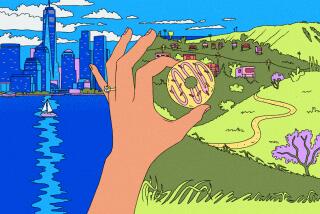Lovers Struggle to Leap Across a Cultural Divide
- Share via
THE LOST DAUGHTER
OF HAPPINESS
By Geling Yan
Translated from the Chinese
by Cathy Silber
Hyperion
$22.95, 288 pages
*
Can a man and a woman love each other without understanding each other in the least? Can love overcome racial prejudice, or do the two emotions run on separate tracks and rarely collide?
Geling Yan, who left China after the Tiananmen Square massacre in 1989 and now lives with her American husband in San Francisco, considers these questions in an odd but striking novel set in the late 19th century. She considers the plight of an earlier immigrant, Fusang, a Chinese village girl kidnapped and brought to “Gold Mountain”--California--to be a prostitute.
No less than the blacks the Civil War had just freed, Fusang is a slave. The voyage she endures is as harrowing as the Middle Passage. One of Yan’s points is how little the immigrant experience has changed for some, despite the waning of overt discrimination. Reading of dead girls thrown overboard in the 1860s, we think of contemporary Chinese workers who dream of Western gold, entrust their fates to smugglers and are found suffocated in trucks and cargo containers.
Yan says she and her husband studied 160 mostly forgotten histories of the Chinese in San Francisco to provide the background for this tale. Fusang was a real person, noted in the histories for, among other things, simply surviving. The typical prostitute began work in Chinatown’s brothel cages at 14 and was dead by 20 of disease, beatings and overwork.
Fusang was 20 when she arrived and lived a normal span, thanks to good luck, powerful protectors and the fame of her beauty, which included bound feet--”four-inch golden lotuses.” Yan also gives her a warm smile and an accepting and forgiving disposition, which many mistake for mental slowness and which Yan herself--addressing Fusang over a gap of more than a century--often complains that she can’t understand.
It’s hard enough, Yan admits, for her and her husband to understand one another over the lesser cultural divide that exists today. So how can Chris Koehler, the fictional American boy who longs to rescue Fusang from slavery, understand how she can be free in spirit despite it? And how can Fusang understand the muddle of anger and idealism that makes Chris want to murder her pimp, Da Yong, burn down Chinatown to destroy the whole culture that oppresses her, and take her to another state--marriages between whites and Asians in California then being illegal?
He can’t, Yan concludes. And she can’t. But they love each other just the same.
One of Chris’ problems is that he’s only 12 when he first meets Fusang. (Sex between very young white boys and Chinese prostitutes was common enough to be decried as a social evil, Yan says the histories told her.) The men in his wealthy family all keep mistresses, some of other races, and rather relish the guilt involved in compartmentalizing their lives. Chris is young enough to want to do better, though for several years he’s also too young to do more than wait.
Da Yong, who is probably a composite of historical Chinatown gangsters, is a larger-than-life figure in Yan’s hands. He’s brutal and intelligent and charming, an escape artist, a dandy, a killer, a horse breaker, a race fixer, a railroad strike leader and, just possibly, the long-lost husband to whom Fusang was betrothed as an infant.
Neither man can comprehend the other’s feelings for Fusang, any more than the Christian ladies who “rescue” Chinese girls from the brothels, unbind their feet and teach them Bible reading and cleanliness quite know what they’re doing--any more than Fusang herself realizes that a bloody tong war viewed by applauding whites from their balconies had its origin in a quarrel over her.
Like a filmmaker whose camera style is both austere and lush, Yan lingers on moments of mute tenderness, pans over the backdrop of saloons and opium dens and gives us a vivid but sidelong, wincing view of atrocities--slave auctions of naked girls, anti-Chinese riots, a gang rape in which Chris, to his horror, is a participant.
All three main characters in “The Lost Daughter of Happiness” are, in the end, enigmas--not just to one another but to us. Yet one of Yan’s achievements in this novel is to make the anti-Chinese feeling that disfigured the period seem so natural--an all-too-human reaction to workers who “offered themselves up for exploitation” and drove down everyone else’s wages; to vice lords with “dark and gentle eyes” who “made cruelty and evil impossible to explain or define”; to all-enduring immigrants who “would bow their heads and patiently wait for you to get out of the way. And sure enough their patience would end up making you leave.”


